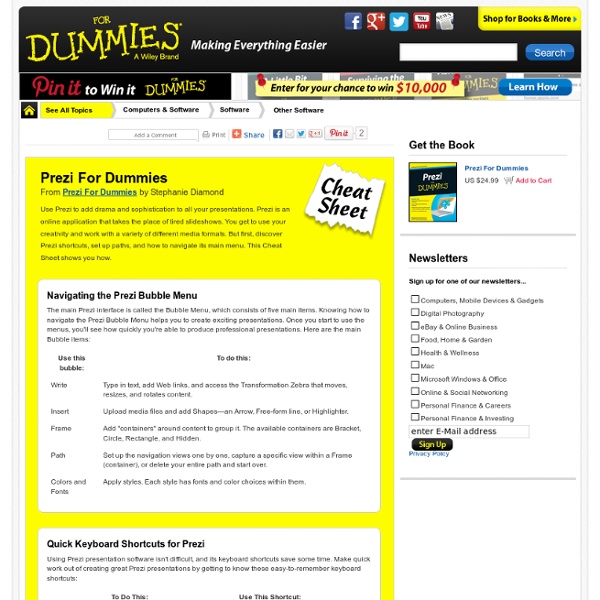Prezi For Dummies Cheat Sheet
Cheat Sheet Use Prezi to add drama and sophistication to all your presentations. Prezi is an online application that takes the place of tired slideshows. Navigating the Prezi Bubble Menu The main Prezi interface is called the Bubble Menu, which consists of five main items. Quick Keyboard Shortcuts for Prezi Using Prezi presentation software isn't difficult, and its keyboard shortcuts save some time. Handy Shortcuts in Prezi's Show Mode Prezi has two different modes of operation: Edit Mode, in which you create your presentation, and Show Mode, in which you present your creations. Media Formats to Use with Prezi With Prezi, you have the opportunity to include a variety of media that to make your presentations really stand out from the usual boring slide shows. Any image in a Vector, JPG, PNG or GIF format: Maximum size for an uploaded image is 2880 x 2880. How to Use the Prezi Path Tool Prezi has a Path tool that you use to set up and follow your storyline.
Library
As of July 1, 2013 ThinkQuest has been discontinued. We would like to thank everyone for being a part of the ThinkQuest global community: Students - For your limitless creativity and innovation, which inspires us all. Teachers - For your passion in guiding students on their quest. Partners - For your unwavering support and evangelism. Parents - For supporting the use of technology not only as an instrument of learning, but as a means of creating knowledge. We encourage everyone to continue to “Think, Create and Collaborate,” unleashing the power of technology to teach, share, and inspire. Best wishes, The Oracle Education Foundation
Related:
Related:



